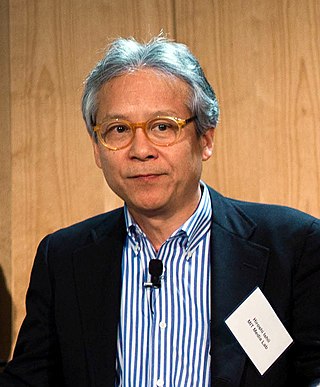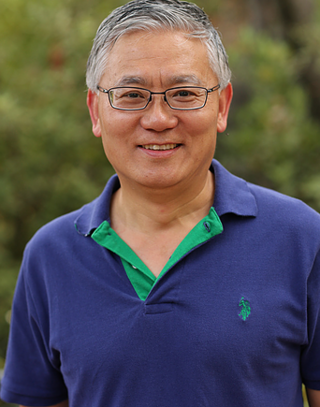
In human–computer interaction, WIMP stands for "windows, icons, menus, pointer", denoting a style of interaction using these elements of the user interface. Other expansions are sometimes used, such as substituting "mouse" and "mice" for menus, or "pull-down menu" and "pointing" for pointer.
The following outline is provided as an overview of and topical guide to human–computer interaction:

Gesture recognition is an area of research and development in computer science and language technology concerned with the recognition and interpretation of human gestures. A subdiscipline of computer vision, it employs mathematical algorithms to interpret gestures. Gestures can originate from any bodily motion or state, but commonly originate from the face or hand. One area of the field is emotion recognition derived from facial expressions and hand gestures. Users can make simple gestures to control or interact with devices without physically touching them. Many approaches have been made using cameras and computer vision algorithms to interpret sign language, however, the identification and recognition of posture, gait, proxemics, and human behaviors is also the subject of gesture recognition techniques. Gesture recognition is a path for computers to begin to better understand and interpret human body language, previously not possible through text or unenhanced graphical (GUI) user interfaces.
Human-centered computing (HCC) studies the design, development, and deployment of mixed-initiative human-computer systems. It is emerged from the convergence of multiple disciplines that are concerned both with understanding human beings and with the design of computational artifacts. Human-centered computing is closely related to human-computer interaction and information science. Human-centered computing is usually concerned with systems and practices of technology use while human-computer interaction is more focused on ergonomics and the usability of computing artifacts and information science is focused on practices surrounding the collection, manipulation, and use of information.
In the field of human–computer interaction, a Wizard of Oz experiment is a research experiment in which subjects interact with a computer system that subjects believe to be autonomous, but which is actually being operated or partially operated by an unseen human being.
Andrew Sears is an American computer scientist. He is a professor and dean of the College of Information Sciences and Technology (IST) at The Pennsylvania State University.

Hiroshi Ishii is a Japanese computer scientist. He is a professor at the Massachusetts Institute of Technology. Ishii pioneered the Tangible User Interface in the field of Human-computer interaction with the paper "Tangible Bits: Towards Seamless Interfaces between People, Bits and Atoms", co-authored with his then PhD student Brygg Ullmer.
Elizabeth D. "Beth" Mynatt is the Dean of the Khoury College of Computer Sciences at Northeastern University. She is former executive director of the Institute for People and Technology, director of the GVU Center at Georgia Tech, and Regents' and Distinguished Professor in the School of Interactive Computing, all at the Georgia Institute of Technology.

Human–computer interaction (HCI) is research in the design and the use of computer technology, which focuses on the interfaces between people (users) and computers. HCI researchers observe the ways humans interact with computers and design technologies that allow humans to interact with computers in novel ways. A device that allows interaction between human being and a computer is known as a "Human-computer Interface (HCI)".

Marti Hearst is a professor in the School of Information at the University of California, Berkeley. She did early work in corpus-based computational linguistics, including some of the first work in automating sentiment analysis, and word sense disambiguation. She invented an algorithm that became known as "Hearst patterns" which applies lexico-syntactic patterns to recognize hyponymy (ISA) relations with high accuracy in large text collections, including an early application of it to WordNet; this algorithm is widely used in commercial text mining applications including ontology learning. Hearst also developed early work in automatic segmentation of text into topical discourse boundaries, inventing a now well-known approach called TextTiling.
The Human Media Lab(HML) is a research laboratory in Human-Computer Interaction at Queen's University's School of Computing in Kingston, Ontario. Its goals are to advance user interface design by creating and empirically evaluating disruptive new user interface technologies, and educate graduate students in this process. The Human Media Lab was founded in 2000 by Prof. Roel Vertegaal and employs an average of 12 graduate students.
Victoria Bellotti is a Senior CI researcher in the Member Experience Team at Netflix. Previously, she was a user experience manager for growth at Lyft and a research fellow at the Palo Alto Research Center. She is known for her work in the area of personal information management and task management, but from 2010 to 2018 she began researching context-aware peer-to-peer transaction partner matching and motivations for using peer-to-peer marketplaces which led to her joining Lyft. Victoria also serves as an adjunct professor in the Jack Baskin School of Engineering at University of California Santa Cruz, on the editorial board of the Personal and Ubiquitous Computing and as an associate editor for the International Journal of HCI. She is a researcher in the Human–computer interaction community. In 2013 she was awarded membership of the ACM SIGCHI Academy for her contributions to the field and professional community of human computer interaction.
Sarah Ann Douglas is a distinguished computer scientist, known for her work in human-computer interaction (HCI), a field of computer science that she has helped pioneer, and, in particular, pointing devices and haptic interactions, WWW interfaces and bioinformatics, and visualization and visual interfaces. She is a Professor Emerita of Computer and Information Science and a member of the Computational Science Institute at the University of Oregon.
Feminist HCI is a subfield of human-computer interaction (HCI) that applies feminist theory, critical theory and philosophy to social topics in HCI, including scientific objectivity, ethical values, data collection, data interpretation, reflexivity, and unintended consequences of HCI software. The term was originally used in 2010 by Shaowen Bardzell, and although the concept and original publication are widely cited, as of 2020 Bardzell's proposed frameworks have been rarely used since.

Jacob O. Wobbrock is a Professor in the University of Washington Information School and, by courtesy, in the Paul G. Allen School of Computer Science & Engineering at the University of Washington. He is Director of the ACE Lab, Associate Director and founding Co-Director Emeritus of the CREATE research center, and a founding member of the DUB Group and the MHCI+D degree program.

Wendy Elizabeth Mackay is a Canadian researcher specializing in human-computer interaction. She has served in all of the roles on the SIGCHI committee, including Chair. She is a member of the CHI Academy and a recipient of a European Research Council Advanced grant. She has been a visiting professor in Stanford University between 2010 and 2012, and received the ACM SIGCHI Lifetime Service Award in 2014.
Joëlle Coutaz is a French computer scientist, specializing in human-computer interaction (HCI). Her career includes research in the fields of operating systems and HCI, as well as being a professor at the University of Grenoble. Coutaz is considered a pioneer in HCI in France, and in 2007, she was awarded membership to SIGCHI. She was also involved in organizing CHI conferences and was a member on the editorial board of ACM Transactions on Computer-Human Interaction.
Andrew Cockburn is currently working as a Professor in the Department of Computer Science and Software Engineering at the University of Canterbury in Christchurch, New Zealand. He is in charge of the Human Computer Interactions Lab where he conducts research focused on designing and testing user interfaces that integrate with inherent human factors.

Shumin Zhai is a Chinese-born American Canadian Human–computer interaction (HCI) research scientist and inventor. He is known for his research specifically on input devices and interaction methods, swipe-gesture-based touchscreen keyboards, eye-tracking interfaces, and models of human performance in human-computer interaction. His studies have contributed to both foundational models and understandings of HCI and practical user interface designs and flagship products. He previously worked at IBM where he invented the ShapeWriter text entry method for smartphones, which is a predecessor to the modern Swype keyboard. Dr. Zhai's publications have won the ACM UIST Lasting Impact Award and the IEEE Computer Society Best Paper Award, among others, and he is most known for his research specifically on input devices and interaction methods, swipe-gesture-based touchscreen keyboards, eye-tracking interfaces, and models of human performance in human-computer interaction. Dr. Zhai is currently a Principal Scientist at Google where he leads and directs research, design, and development of human-device input methods and haptics systems.

Quincy K. Brown is an American computer scientist and former Senior Policy Advisor in the White House Office of Science and Technology Policy. She is a published academic and co-founder of blackcomputeHER.org, NationOfMakers.org and Black In Computing.








